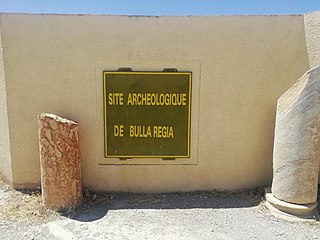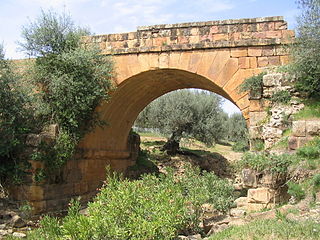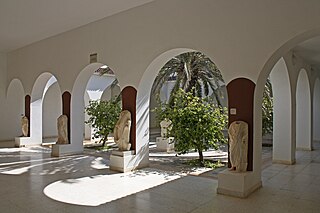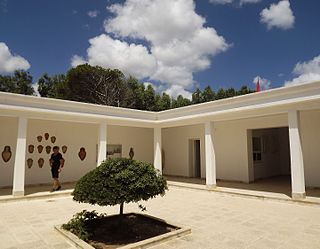
Jendouba is a city in northwestern Tunisia, and capital of the Jendouba Governorate. It is an important crossroads with many road links to other towns such as El Kef, Tabarka, Ain Draham and Béja. The main economic activity is agriculture. It is close to the famous ancient Roman city of Bullaregia or Bulla Regia, as well as the ancient marble quarry of Chemtou. The city's name is derived from Amazigh with the exact translation being “land of grain.”

The Roman circus was a large open-air venue used for public events in the ancient Roman Empire. The circuses were similar to the ancient Greek hippodromes, although circuses served varying purposes and differed in design and construction. Along with theatres, amphitheatres, and the similar but much smaller stadiums, circuses were one of the main entertainment sites of the time. Circuses were venues for chariot races, horse races, gladiatorial combat, and performances that commemorated important events of the Empire were performed there.

The Catholic Church in Tunisia is part of the worldwide Catholic Church, under the spiritual leadership of the Pope in Rome.

Bulla Regia was a Berber, Punic, and Roman town near present-day Jendouba, Tunisia. Its surviving ruins and archaeological site are noted for their Hadrianic-era semi-subterranean housing, a protection from the fierce heat and effects of the sun. Many of the mosaic floors have been left in place; others may be seen at the Bardo Museum in Tunis. There is also a small museum connected with the site.

Thuburnica was an ancient Roman-Berber city in the Maghreb. It was located in the present-day El Kalâa, near Chemtou in western Tunisia. It may have been the ancient town of Bulla Regia.

RPM Nautical Foundation is a non-profit archaeological research and educational organization dedicated to the advancement of maritime archaeology that includes littoral surveys and excavation of individual shipwreck and harbor sites.

El Djem Archaeological Museum is an archaeological museum located in El Djem, Tunisia. It contains Roman era art, including mythological personages, abstract elements and fauna.

Kerkouane Archaeological Museum is an archaeological museum located in Kerkouane, Tunisia. It contains statuary, jewelry and ceramic art.

The Sousse Archaeological Museum is an archaeological museum located in Sousse, Sousse Governorate, Tunisia.

The Carthage Paleo-Christian Museum is an archaeological museum of Paleochristian artifacts, located in Carthage, Tunisia. Built on an excavation site, it lies above the former Carthaginian basilica.

The Chemtou Museum is an archaeological museum located in Chemtou, Tunisia. The museum was designed by archaeologists with the Tunisian National Heritage Institute and the German Archaeological Institute with offices located in Rome, Italy. It has the distinction of being located in the area of the old Roman city of Simmithu, near the entrepot's marble quarry in what was the ancient Berber kingdom of Numidia.
Sers, also Le Sers or Es Sers, is a town and commune in the Kef Governorate, Tunisia. It is located 35.5 kilometres (22.1 mi) by road southeast of El Kef. As of 2004 it had a population of 11,927. Its economic activity is mainly dominated by agriculture, including cereal production.
Presently, in Africa, Google Street View can be seen in parts of Botswana, Uganda, South Africa, Kenya, Eswatini, Lesotho, Senegal, Ghana, Tunisia, Nigeria, Rwanda, the Canary Islands of Spain, and Egypt's landmarks.
Sidi-Meskin is a railway town, and archaeological site in Gouvernorat of Jendouba, Northern Tunisia. It is located in the Medjerda valley at 36.45N, 8.66E, outside of Bou Salem and is nearby to Djendouba, Mechtat el Anad and Djebel Bou Rbah. The town is located at an elevation of 430 meters above sea level, and has a mosque and railroad station.

Louis Carton was a French physician and archaeologist who was active in Tunisia.
Blastococcus xanthinilyticus is a Gram-positive and non-motile bacterium from the genus of Blastococcus which has been isolated from marble dust from the Bulla Regia monument in Tunisia.

Dhaymoole is an archaeological site in the Sahil province of Somaliland. The site is a cave that contains a collection of ancient rock drawings showing a variety of animals as well as some unidentified symbols. These drawings were created during the third millennium BC.

Atiq Mosque is located in Ghadames, Libya. Originally constructed in 1258, it is one of the main and largest mosque of the old town of Ghadames.
















